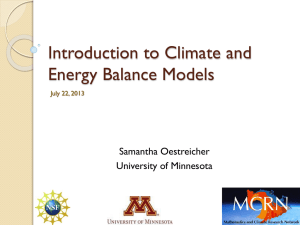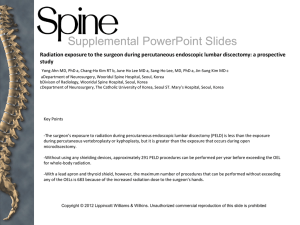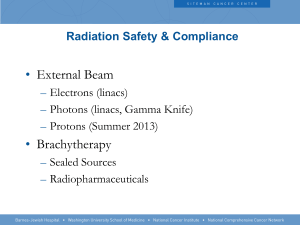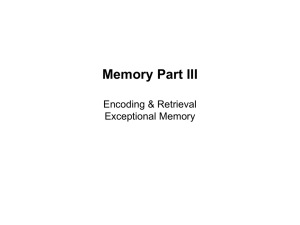Powerpoint
advertisement
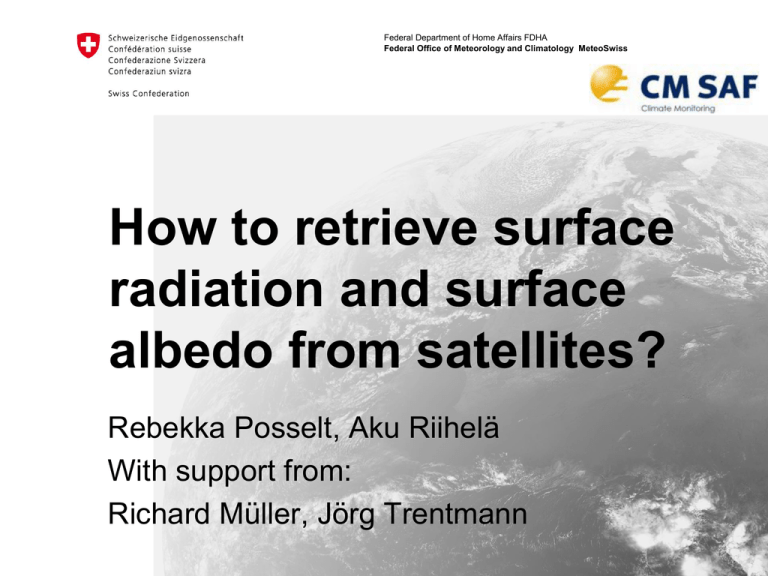
Federal Department of Home Affairs FDHA Federal Office of Meteorology and Climatology MeteoSwiss How to retrieve surface radiation and surface albedo from satellites? Rebekka Posselt, Aku Riihelä With support from: Richard Müller, Jörg Trentmann Outline PART I Solar radiation (SIS, SID) • MagicSol – Retrieval for historical radiation datasets • LookUpTable radiation retrieval Longwave radiation (SDL) • AVHRR-CLARA (GAC) algorithm (very short) PART II Surface albedo (SAL) CM SAF Event Week, Surface radiation retrieval 2 Retrieval Overview Variables Algorithm Cloud Albedo Solar Surf. Rad. MAGIC Sensor Satellite Satelliteorbit MVIRI G2R Cloud Macrophysics SAFNWC/ MSG Cloud Microphysics CPP Solar & Thermal Rad. at Top -of-atm. ToA-Rad Satellite Sensor AMSU + HIRS MFG Solar & Thermal Surf. Rad Satelliteorbit Geostat. SEVIRI MSG R E T R I Polar E V A L S GERB CM SAF Event Week, Surface radiation retrieval NOAA (ATOVS) METOP AVHRR Algorithm IAPP Atmospheric Watervapour & temperature SAFNWC/ PPS Cloud Macrophysics CPP Cloud Microphysics P2R Solar & Thermal Surf. Rad.; Cloud forcing HOAPS Water- & EnergyFluxes Over ocean DMSP SSM/I Variables 3 Federal Department of Home Affairs FDHA Federal Office of Meteorology and Climatology MeteoSwiss Part I Surface radiation retrievals Rebekka Posselt (MeteoSwiss) Contact me at: rebekka.posselt@meteoswiss.ch Outline PART I Solar radiation (SIS, SID) • MagicSol – Retrieval for historical radiation datasets • LookUpTable radiation retrieval Longwave radiation (SDL) • AVHRR-CLARA (GAC) algorithm (very short) PART II Surface albedo (SAL) CM SAF Event Week, Surface radiation retrieval 5 MagicSol Retrieval for historical radiation datasets • Historical = Meteosat 2 – 7 (1983 – 2005) = MVIRI instrument • Benefits: • 23 years of high resolution data climatology • Challenges: • Only three available channels (VIS, IR, WV) • Satellite operations not designed for climate studies • Different satellites (inhomogeneities) • Poorly documented (M2-4 missing calibration) CM SAF Event Week, Surface radiation retrieval 6 MagicSol Retrieval for historical radiation datasets • Historical = Meteosat 2 – 7 (1983 – 2005) = MVIRI instrument • Benefits: • 23 years of high resolution data climatology • Challenges: • Only three available channels (VIS, IR, WV) • Satellite operations not designed for climate studies • Different satellites (inhomogeneities) • Poorly documented (M2-4 missing calibration) CM SAF Event Week, Surface radiation retrieval 7 MagicSol Retrieval for historical radiation datasets • Retrieval scheme 1. Get cloud information • “Effective Cloud Albedo” (CAL) • From satellite 2. Get clear sky information • “Clear Sky Radiation” (Radcs) • From LookUpTables 3. Combine 1. & 2. 𝑹𝒂𝒅 = 𝒇 𝑪𝑨𝑳 ∙ 𝑹𝒂𝒅𝒄𝒔 ≈ 𝟏 − 𝑪𝑨𝑳 ∙ 𝑹𝒂𝒅𝒄𝒔 Rad = SIS or SID CM SAF Event Week, Surface radiation retrieval 8 MagicSol Retrieval for historical radiation datasets 1. Get cloud information • Get clear sky = cloud free = surface only image from a series of original images (usually the darkest pixel in the series) Original image (clouds and surface) = ρ Clear sky image (clouds removed, only surface) = ρmin CM SAF Event Week, Surface radiation retrieval Cloud image (surface removed, only clouds) 9 MagicSol Retrieval for historical radiation datasets 1. Get cloud information • Get Selfcalibration via ρmax = 95% percentile of all counts in target region (South Atlantic) Original image CM SAF Event Week, Surface radiation retrieval 10 MagicSol Retrieval for historical radiation datasets 1. Get cloud information • All information together give the “effective cloud albedo” (CAL, a.k.a. cloud index) Heliosat method 𝑪𝑨𝑳 = 𝝆−𝝆𝒎𝒊𝒏 𝝆𝒎𝒂𝒙 −𝝆𝒎𝒊𝒏 Cloud image ~ Maximum range of pixel brightnesses CM SAF Event Week, Surface radiation retrieval 11 MagicSol Retrieval for historical radiation datasets 1. Get cloud information • All information together give the “effective cloud albedo” (CAL, a.k.a. cloud index) Heliosat method 𝑪𝑨𝑳 = 𝝆−𝝆𝒎𝒊𝒏 𝝆𝒎𝒂𝒙 −𝝆𝒎𝒊𝒏 Cloud image ~ Maximum range of pixel brightnesses • Overcast CAL= ? • Clear-sky CAL = ? • Fresh snow CAL < 0, 0<CAL<1, CAL>1 CM SAF Event Week, Surface radiation retrieval 12 MagicSol Retrieval for historical radiation datasets 2. Get clear sky radiation (gnu-magic) Atmospheric State • Aerosols (climatology) • Water vapour (reanalysis) • Ozone LookUpTable Surface Albedo • Climatology Interpolation • LookUpTables Fast Obtained from a Radiative Transfer Model CM SAF Event Week, Surface radiation retrieval Radcs 13 Müller et al. (2009) http://sourceforge.net/projects/gnu-magic MagicSol Retrieval for historical radiation datasets • Retrieval scheme 1. Get cloud information • “Effective Cloud Albedo” (CAL) • From satellite 2. Get clear sky information • “Clear Sky Radiation” (Radcs) • From LookUpTables 3. Combine 1. & 2. 𝑹𝒂𝒅 = 𝒇 𝑪𝑨𝑳 ∙ 𝑹𝒂𝒅𝒄𝒔 ≈ 𝟏 − 𝑪𝑨𝑳 ∙ 𝑹𝒂𝒅𝒄𝒔 Rad = SIS or SID CM SAF Event Week, Surface radiation retrieval 14 Outline PART I Solar radiation (SIS, SID) • MagicSol – Retrieval for historical radiation datasets • LookUpTable radiation retrieval Longwave radiation (SDL) • GAC algorithm (very short) PART II Surface albedo (SAL) CM SAF Event Week, Surface radiation retrieval 15 LookUpTable radiation retrieval • Used for • Operational (= regularly updated) radiation products • AVHRR-CLARA (GAC) radiation dataset • Benefits: • Physical approach • Applicable to geostationary and polar orbiting satellites • Challenges: • Multispectral information required for cloud detection • Auxiliary data required (e.g., surface albedo) CM SAF Event Week, Surface radiation retrieval 16 LookUpTable radiation retrieval • Retrieval scheme 1. Cloud detection 2. Cloud free: use clear-sky gnu-magic (see MAGICSOL) CM SAF Event Week, Surface radiation retrieval 17 LookUpTable radiation retrieval • Retrieval scheme 1. Cloud detection 2. Cloudy: Get atmospheric trans-missivity τ from LUT • Use satellite and model data as input 3. Calculate Rad 𝑹𝒂𝒅 = 𝑬𝟎 ∙ 𝒄𝒐𝒔𝚯𝒛 ∙ 𝝉 E0 = solar constant = 1362 Wm-2 Θz = sun-zenith angle τ = atmospheric transmissivity CM SAF Event Week, Surface radiation retrieval 18 LookUpTable radiation retrieval • Retrieval scheme 1. Cloud detection 2. Cloudy: Get atmospheric trans-missivity τ from LUT • Use satellite and model data as input 3. Calculate Rad 𝑹𝒂𝒅 = 𝑬𝟎 ∙ 𝒄𝒐𝒔𝚯𝒛 ∙ 𝝉 E0 = solar constant = 1362 Wm-2 known Θz = sun-zenith angle known τ = atmospheric transmissivity use cloud-magic CM SAF Event Week, Surface radiation retrieval 19 LookUpTable radiation retrieval 1. Get atmospheric transmissivity τ (cloud-magic) TOA albedo • GERB (CM SAF RMIB) or GERB-like-SEVIRI • AVHRR-CLARA (GAC) broadband albedo LookUpTable Atmospheric State • • • • Aerosols (climatology) Water vapour (NWP DWD) Ozone Cloud fraction (SAFNWC) Interpolation Surface Albedo • Climatology CM SAF Event Week, Surface radiation retrieval Atmospheric Transmissivity τ 20 Müller et al. (2009) http://sourceforge.net/projects/gnu-magic LookUpTable radiation retrieval • Retrieval scheme 1. Cloud detection 2. Cloudy: Get atmospheric trans-missivity τ from LUT • Use satellite and model data as input 3. Calculate Rad 2. Cloud free: use clearsky gnu-magic (see MAGICSOL) 𝑹𝒂𝒅 = 𝑬𝟎 ∙ 𝒄𝒐𝒔𝚯𝒛 ∙ 𝝉 E0 = solar constant = 1362 Wm-2 Θz = sun-zenith angle τ = atmospheric transmissivity CM SAF Event Week, Surface radiation retrieval 21 Outline PART I Solar radiation (SIS, SID) • MagicSol – Retrieval for historical radiation datasets • LookUpTable radiation retrieval Longwave radiation (SDL) • AVHRR-CLARA (GAC) algorithm (very short) PART II Surface albedo (SAL) • Arctic-SAL CM SAF Event Week, Surface radiation retrieval 22 AVHRR-CLARA (GAC) SDL retrieval - very short • GAC = “global area coverage” = AVHRR instrument (1982-present), polar orbiting • SDL mainly determined by Temperature and humidity close to the earth’s surface • Cannot be observed by satellites all SDL products from satellites need additional data (e.g., reanalysis, NWP) • CM SAF GAC SDL uses ERA Interim SDL as basis • Cloud information of GAC are used to refine ERA SDL CM SAF Event Week, Surface radiation retrieval 23 Outline PART I Solar radiation (SIS, SID) • MagicSol – Retrieval for historical radiation datasets • LookUpTable radiation retrieval Longwave radiation (SDL) • GAC algorithm (very short) PART II Surface albedo (SAL) CM SAF Event Week, Surface radiation retrieval 24 PART II SAL retrieval algorithm Aku Riihelä FMI Surface albedo Radiation budget at surface: Enet = SW↓ – α * SW↓ + LW ↓ - LW↑ The resulting net energy is available for surface heating, snow melt, heat fluxes etc. SW↓ - α* SW↓ + LW ↓ - LW ↑ CM SAF Event Week, Surface radiation retrieval 26 The SAL algorithm • A shortwave black-sky surface albedo product • Black-sky = direct solar flux only, all atmospheric effects removed • A radiometric and geolocation correction for topography effects on AVHRR images • Dedicated algorithms for vegetated surfaces, snow/ice, and water • Atmospheric correction with SMAC • BRDF correction over vegetated surfaces CM SAF Event Week, Surface radiation retrieval 27 0. Topography correction In the first part, we correct the geolocation of the AVHRR pixels for the true terrain height effects using a global DEM In the second part, we correct the observed reflectances for effects caused by the various slopes and shadowed areas in an AVHRR pixel CM SAF Event Week, Surface radiation retrieval 28 1. Atmospheric correction • Atmospheric effects need to be removed from the observed TOA reflectances • We use the Simplified Model for Atmospheric Correction (SMAC) [Rahman & Dedieu, 1994]. • Required Inputs • Visible + near IR TOA reflectances • Aerosol Optical Depth (AOD) content of the atmosphere (set constant to 0.1) • Total ozone column (O3) (constant at 0.35 (atm cm)) • Total column water vapour and surface pressure (taken from atmospheric model, ECMWF / DWD (g/cm^2)) CM SAF Event Week, Surface radiation retrieval 29 2. BRDF correction • Applied the model of Roujean (1992) with an update by Wu et al. (1995). • The model considers the bidirectional reflectance of a surface to consist of three ”kernels”: 𝜌 = 𝑘0 + 𝑘𝑔𝑒𝑜 𝑓𝑔𝑒𝑜 + 𝑘𝑣𝑜𝑙 𝑓𝑣𝑜𝑙 CM SAF Event Week, Surface radiation retrieval 30 2. BRDF correction • Applied the model of Roujean (1992) with an update by Wu et al. (1995). • The model considers the bidirectional reflectance of a surface to consist of three ”kernels”: 𝜌 = 𝑘0 + 𝑘𝑔𝑒𝑜 𝑓𝑔𝑒𝑜 + 𝑘𝑣𝑜𝑙 𝑓𝑣𝑜𝑙 Generic vegetation canopy! CM SAF Event Week, Surface radiation retrieval k terms describe the reflectance contributions from: • nadir-viewing & overhead Sun situation (k0), • geometric and volume scattering terms k1 and k2. The f terms describe the dependency of the model from the viewing/illumination geometry of the scene. 31 2.5. Anisotropy sampling of snow • The reflectance anisotropy properties of snow vary widely with snow type! • Very difficult to model universally without universal data on snow physical characteristics • Our solution: sample the anisotropy directly and consider the mean of the samples to represent the albedo. • The strategy works if we have enough samples of the BRDF…which fortunately is the case when using AVHRR in the high latitudes (where snow exists)! Reflectance sampling distribution at Summit Camp, Greenland Ice Sheet, summer 2005 CM SAF Event Week, Surface radiation retrieval 32 3. Narrow-to-broadband conversion Satellite imagers cover only a part of the solar spectrum – algorithms needed to convert observed (spectral) albedo to full broadband albedo! NTBC algorithms separated by instrument (SEVIRI / AVHRR) and land cover (vegetation, snow, water) Vegetation-AVHRR: Liang (2000) Vegetation-SEVIRI: Van Leeuwen & Roujean (2002) Snow: Xiong et al. (2002) AVHRR channels 1&2 CM SAF Event Week, Surface radiation retrieval Water (LUT-based): Jin et al. (2004) 33 When all is said and done… • We have retrieved a broadband black-sky surface albedo for a satellite image* • The instantaneous images are then projected into a common map grid and averaged over a pentad/week/month to create the product we distribute to You, the user. * Multiple images required for a robust snow albedo retrieval CM SAF Event Week, Surface radiation retrieval 34 Limitations of the algorithm 1. Sun Zenith Angle of the scene has to be less than 70 degrees and the Viewing Zenith Angle (of the satellite) less than 60 degrees • Retrievals would be unreliable outside these bounds 2. Cloud masking errors do occur sporadically • Cloud reflectance propagates into an albedo ”retrieval” 3. Aerosols and O3 concentrations currently constant in retrievals • Increased uncertainty over areas where AOD is high (see figure below) • O3 effect is much smaller than the aerosol effect 4. Coarse resolution (15 km2, 0.25 degrees, 25 km2) may not allow for accurate small-scale studies Problems using SAL? You can contact me at aku.riihela@fmi.fi CM SAF Event Week, Surface radiation retrieval 35 CM SAF Event Week, Surface radiation retrieval 36



